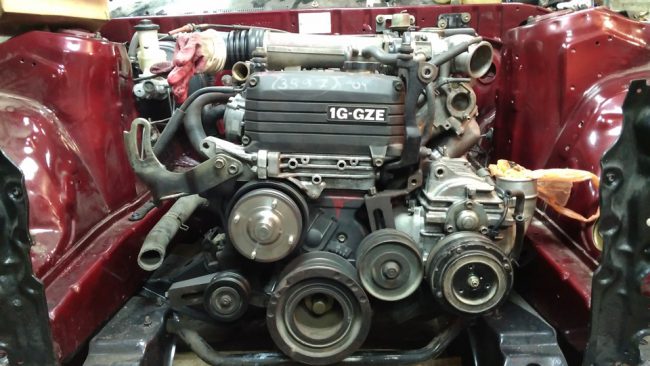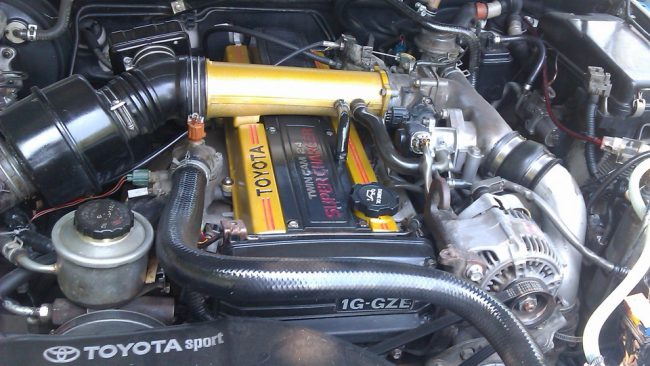
Engine Toyota 1G-GZE
Content
Toyota's early turbocharged engine is the 1G-GZE engine. This is one of the modifications of the 2-liter 1G family with rather pleasant characteristics and a good resource. A serious difference from the relatives of the unit was the presence of DIS electronic ignition, as well as a fairly reliable turbocharger. The increase in power and torque had practically no effect on the reliability of the motor, but it did not stay on the conveyor for long - from 1986 to 1992.

Like all representatives of the line, this is a simple in-line "six" with 4 valves per cylinder (24 valves in total). The cast iron block allowed repairs to be made, but several technological innovations made the service rather difficult for general shops. With this series, Toyota engines began to orient the buyer of the car to the official service center. By the way, the internal combustion engine was produced only for the domestic market of Japan, but it sold well around the world.
Specifications of the motor 1G-GZE
In the history of the company, there are various additional names for this unit. This is Supercharger or Supercharged. This is due to the fact that a modified traditional compressor for powerful gasoline engines at that time was called a charger. In fact, this is an analogue of the design of a modern turbine. And there were no particular problems with this mechanism.
The main technical characteristics of this motor are as follows:
| Working volume | 2.0 liters |
| Number of cylinders | 6 |
| Number of valves | 24 |
| Gas distribution system | DOHC |
| Power | 168 h.p. at 6000 rpm |
| Torque | 226 N * m at 3600 rpm |
| Supercharger | present |
| Ignition | electronic DIS (contactless) |
| Compression ratio | 8.0 |
| Fuel injection | distributed EFI |
| Fuel consumption | |
| - town | 13 |
| - track | 8.5 |
| Gear boxes | only automatic transmission |
| Resource (according to reviews) | 300 km or more |
The main advantages of the 1G-GZE motor
A reliable cylinder block and excellent cylinder head design are just the beginning of the list of advantages that can be found for the family. It is the GZE version that can offer interesting features, such as the presence of 7 excellent injectors (1 is used for cold starting), the SC14 supercharger, very popular in "collective farm" tuning around the world.

Also, among the obvious advantages of the unit, it is worth noting the following features:
- One of the few motors that do not have significant oil requirements. However, it is better to serve it with good materials.
- Overheating is not terrible, it is almost impossible, given the design features of the unit.
- The ability to operate on 92nd fuel, but on 95 and 98 the dynamics are noticeably better. Fuel quality is also not critical, it will survive almost any stress.
- The valves do not deform if the timing belt breaks, but the gas distribution system itself is very complex and expensive to maintain.
- Torque is available from low revs, reviews often compare this setup in nature with diesel options for related power.
- Idling is controlled by an electronic unit, so there is no need to set it up, it only needs to be set during a major overhaul or fine tuning of the unit.
Valve adjustment is necessary at every service, it is done in a classic way with the help of nuts. There are no hydraulic lifters and other technologies that would make the motor less practical and would create more serious requirements for the quality of service.
Disadvantages and important features of the operation of the GZE unit
If the compressor on the car works fine and has no bright flaws, then some other peripheral parts bring trouble to the owners. The main problems are hidden in the prices of spare parts, some of which are simply impossible to buy analog.
A few disadvantages are worth evaluating before buying this engine for a swap or ordering a contract engine:
- the pump is only original on the market, a new one is very expensive, pump repair is very difficult;
- the ignition coil is also expensive, but here there are 3 of them, they rarely break, but this happens;
- an oxygen sensor is incredibly expensive, it is almost impossible to find an analogue;
- the design has 5 belt drives, more than a dozen rollers that need to be replaced every 60 km;
- due to the cunning “blade” sensor, the mixture is enriched too much, a different pinout of the computer or a sensor replacement is needed;
- other breakdowns occur - an oil pump, a generator, a throttle valve, a starter (everything breaks more from old age).

It is problematic to replace the temperature sensor. Even setting the ignition on a car is not easy, since each 1G engine has its own labels and instructions. No one has the original manuals anymore, and they were in Japanese. There are amateur recommendations and unofficial repair books, but they can not always be trusted. It is good that the replacement of the distributor will not be needed here, as on other units of the family, it is simply not here.
What cars were equipped with the 1G-GZE engine?
- Crown (until 1992).
- Mark 2.
- Chaser.
- Crest.
This motor was chosen for the same type of cars - heavy large sedans, very popular in Japan in the late 1980s. Overall, the engine was a perfect fit for the car, and the Supercharger lettering on the grille is still prized on these old classic sedans by those in the know.
In Russia, these power plants are most often found on Crowns and Marks.
Tuning and forcing - what is available for GZE?
Enthusiasts are engaged in increasing the power of the motor. At Stage 3, when almost all parts are changed, including the crankshaft, exhaust manifold, intake system, exhaust and even electrical circuits, the motor potential exceeds 320 hp. And at the same time, the resource remains more than 300 km.
From the factory, platinum candles were installed on the engine. Finding the same is very difficult, their cost is high. But when installing any other ignition elements, the engine loses power. So for maximum potential you will need a decent amount of money. And the motors are no longer the newest to experiment with their power and lifespan.
Maintainability – Is a major overhaul available?
Yes, it is possible to overhaul 1G-GZE. But for this you will need to change the rings, look for a fairly rare cylinder head gasket, often change a number of sensors that are also difficult to get. In a major overhaul, a big question is the piston group. It is not easy to find a replacement for standard pistons, you can only increase the volume and turn to used spare parts from other contract machines.

It's easier to buy a contract GZE for 50-60 thousand rubles in good condition. But you will have to check very carefully when buying, right up to disassembly. Very often, on fairly recent proposals with low mileage, speed jumps, complex adjustment of the TPS is necessary, as well as the crankshaft position sensor when installed on another car. It is better to install and tune the engine with specialists.
Conclusions on the old Japanese "six" 1G-GZE
Several conclusions can be drawn from this engine. The unit is great for a swap if you want to replace a failed engine with a Mark 2 or Crown. It is better to buy the device from Japan, but keep in mind some of its subtleties. Diagnosis is complicated, so if your purchase speed jumps, there may be a dozen reasons for such a problem. When installing, you should find a good master.
Reviews claim that 1G spins for a long time after being idle. This is a disease of the entire series, since the injector and ignition system is no longer new. The manufacturability of the motor is estimated by the parameters of the late 80s of the last century, today the engine is already quite outdated. But in general, the unit can please the owner with an economical highway trip and fairly good throttle response in any conditions.

